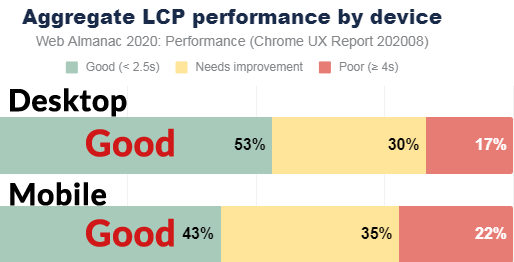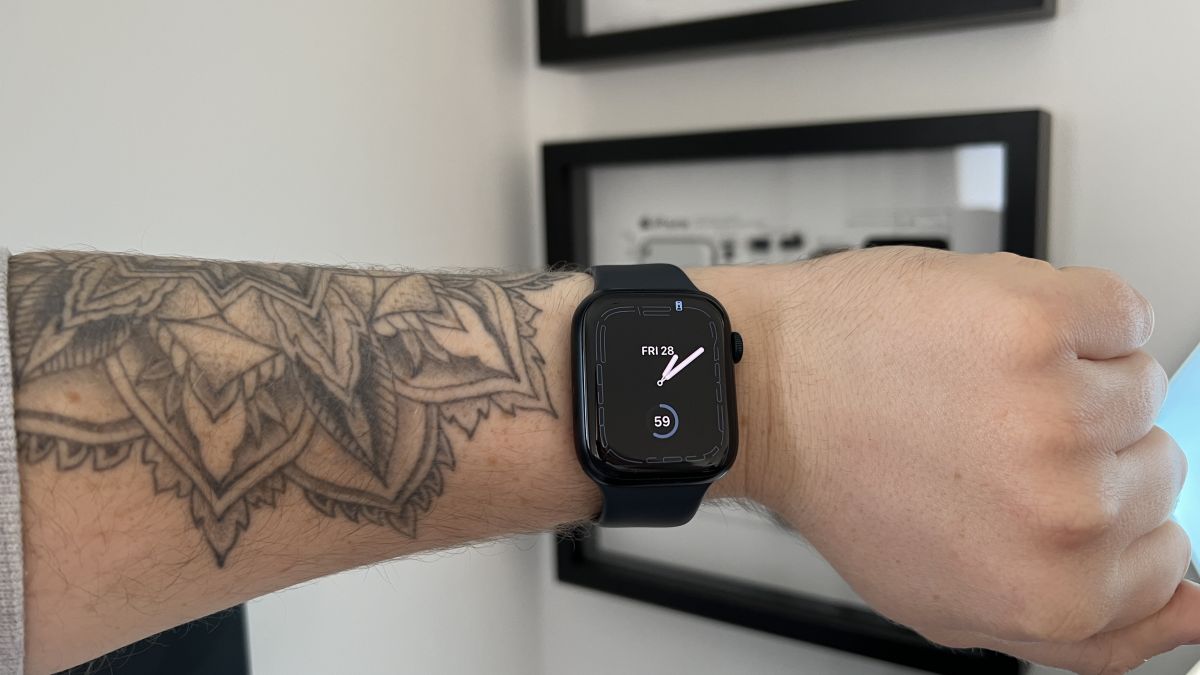The new app is called watchGPT and as I tipped off already, it gives you access to ChatGPT from your Apple Watch. Now the $10,000 question (or more accurately the $3.99 question, as that is the one-time cost of the app) is why having ChatGPT on your wrist is remotely necessary, so let’s dive into what exactly the app can do.
NEWS
Core Web Vitals Challenge: WordPress vs Everyone
HTTP Archive (sister site to Archive.org aka Wayback Machine) published real-world statistics of which content management system (CMS) achieved the best Core Web Vitals scores. The results show that while there was one clear winner, the results show that performance was mixed among all of them.
The HTTP Archive challenge matched WordPress versus Drupal, Joomla, Squarespace and Wix.
Those five were chosen based on their status as the top five most popular content management systems.
Core Web Vitals
Core Web Vitals consists of three metrics that together attempt to provide a snapshot of what the page-level user experience is. The three Core Web Vitals metrics measure how long a site visitor has to wait until they can see the page and begin to make use of it.
The Three Core Web Vitals Metrics
- Largest Contentful Paint (LCP) – Measures when the main content had downloaded, visible and useful to the site visitor.
- First Input Delay – How long a user has to wait for the site to react when interacting with a web page element like a link.
- Cumulative Layout Shift – Measures how long until the content stops shifting around and is stable enough to be successfully interacted with.
Mobile versus Desktop Performance
In general the desktop performance tended to be better than the mobile performance. This may be a reflection of the device’s ability to render a web page and the Internet network differences between a desktop and a mobile device, where a mobile device may have a slower experience.
The mobile Core Web Vital Scores are more important than the desktop scores because the majority of web page visitors access web pages with a mobile device. That is the reason why Google will in May 2021 use the mobile Core Web Vital scores for computing a ranking benefit for sites that have a passing Core Web Vitals score.
Desktop performance scores are important and not to be ignored. But it’s the mobile Core Web Vitals scores that are critical and matter the most.

Scores Explained
The scores are based on actual site visits by users on the Google Chrome browser. These are real-world scores.
The scores are divided between desktop and mobile sites. As explained above, desktop sites scored higher but mobile scores matter most.
Scores are expressed as percentages of websites that achieved a score of good for that particular metric. For example, a good score for Largest Contentful Paint is under 2.5 seconds.
So if a CMS scores 40%, that means 40% of websites had a good score.
Largest Contentful Paint
Largest Contentful Paint (LCP) is a metric that measures when a web page is visible and useful to a site visitor.
The top ranked CMS for LCP is Drupal. The lowest ranked CMS is Wix.
While Drupal was the winner, the Drupal mobile LCP score was only 47%. This means that only 47% of mobile Drupal websites offered site visitors a good user experience in terms of Largest Contentful Paint.
Drupal is the winner but only because the other CMS scores were so bad.
These are the LCP scores
- Drupal – 47%
- Joomla – 38%
- WordPress – 25%
- Squarspace – 12%
- Wix – 9%

First Input Delay
First Input Delay (FID) measures how long it takes from when a user interacts with a site to when the site responds.
The scores for FID were very high. Squarespace was the champion with a score of 91% of sites passed the FID test.
WordPress was close behind in second place while Wix continued to cling to last place.
These are the rankings:
- Squarespace – 91%
- WordPress – 88%
- Drupal – 76%
- Joomla – 71%
- Wix – 46%

Cumulative Layout Shift
Cumulative Layout Shift (CLS) measures how much web page elements like forms, buttons, text and images, etc. shift around. A web page that shifts around is a bad user experience because it’s hard to read text that is sliding up and down/left to right on the phone screen.
The winner was Drupal again, this time with a solid 70% of Drupal sites providing a quality CLS experience. Wix came in third place, narrowly beating WordPress, but not by much.
These are the rankings for CLS
- Drupal – 70%
- Joomla – 63%
- Wix – 59%
- WordPress – 57%
- Squarespace – 44%
While Drupal and Wix might have cause to celebrate, HTTP Archive gave them all a wag of the finger. They observed that the average score for the lot on mobile was 59%.
That means that only 59% of websites using one of the top five CMS presented a good user experience for Cumulative Layout Shift on mobile devices.
This is how HTTP Archive explained it:
“The top 5 CMSs could improve here. Only 50% of web pages loaded by a top 5 CMS have a “good” CLS experience, with this figure rising to 59% on mobile.
Across all CMSs the average desktop score is 59% and average mobile score is 67%. This shows us all CMSs have work to do here, but the top 5 CMSs in particular need improvement.”
Winners and Less Than Winners
Drupal took the top spot twice and Wix took the held on to the bottom twice. WordPress and Joomla battled it out for somewhere in the middle, neither (relatively) nor (relatively) great.
The top five CMS scored decently for First Input Delay. But they turned in not so nice scores for Largest Contentful Paint and Cumulative Layout Shift.
This is important because Google’s making Core Web Vitals a ranking factor.
Even if that factor is a minor ranking factor, it’s still a ranking factor, which makes it important because it is one of the few ranking factors where it’s okay to openly try to influence it.
What makes this ranking factor difficult is that many of the changes necessary to score well in Core Web Vitals involve changes to how the CMS is coded.
That means that any changes to make a site perform better for Core Web Vitals should ideally be handled by the CMS developers and not the users of the CMS.
And that makes the users of WordPress, Drupal, etc less than winners because the resources and skills necessary to make these changes are not within reach of the every publisher.
Read More
HTTP Archive Chrome User Experience Report
Core Web Vitals Not Really Your Problem?
Facebook Faces Yet Another Outage: Platform Encounters Technical Issues Again

Uppdated: It seems that today’s issues with Facebook haven’t affected as many users as the last time. A smaller group of people appears to be impacted this time around, which is a relief compared to the larger incident before. Nevertheless, it’s still frustrating for those affected, and hopefully, the issues will be resolved soon by the Facebook team.
Facebook had another problem today (March 20, 2024). According to Downdetector, a website that shows when other websites are not working, many people had trouble using Facebook.
This isn’t the first time Facebook has had issues. Just a little while ago, there was another problem that stopped people from using the site. Today, when people tried to use Facebook, it didn’t work like it should. People couldn’t see their friends’ posts, and sometimes the website wouldn’t even load.
Downdetector, which watches out for problems on websites, showed that lots of people were having trouble with Facebook. People from all over the world said they couldn’t use the site, and they were not happy about it.
When websites like Facebook have problems, it affects a lot of people. It’s not just about not being able to see posts or chat with friends. It can also impact businesses that use Facebook to reach customers.
Since Facebook owns Messenger and Instagram, the problems with Facebook also meant that people had trouble using these apps. It made the situation even more frustrating for many users, who rely on these apps to stay connected with others.
During this recent problem, one thing is obvious: the internet is always changing, and even big websites like Facebook can have problems. While people wait for Facebook to fix the issue, it shows us how easily things online can go wrong. It’s a good reminder that we should have backup plans for staying connected online, just in case something like this happens again.
NEWS
We asked ChatGPT what will be Google (GOOG) stock price for 2030

Investors who have invested in Alphabet Inc. (NASDAQ: GOOG) stock have reaped significant benefits from the company’s robust financial performance over the last five years. Google’s dominance in the online advertising market has been a key driver of the company’s consistent revenue growth and impressive profit margins.
In addition, Google has expanded its operations into related fields such as cloud computing and artificial intelligence. These areas show great promise as future growth drivers, making them increasingly attractive to investors. Notably, Alphabet’s stock price has been rising due to investor interest in the company’s recent initiatives in the fast-developing field of artificial intelligence (AI), adding generative AI features to Gmail and Google Docs.
However, when it comes to predicting the future pricing of a corporation like Google, there are many factors to consider. With this in mind, Finbold turned to the artificial intelligence tool ChatGPT to suggest a likely pricing range for GOOG stock by 2030. Although the tool was unable to give a definitive price range, it did note the following:
“Over the long term, Google has a track record of strong financial performance and has shown an ability to adapt to changing market conditions. As such, it’s reasonable to expect that Google’s stock price may continue to appreciate over time.”
GOOG stock price prediction
While attempting to estimate the price range of future transactions, it is essential to consider a variety of measures in addition to the AI chat tool, which includes deep learning algorithms and stock market experts.
Finbold collected forecasts provided by CoinPriceForecast, a finance prediction tool that utilizes machine self-learning technology, to anticipate Google stock price by the end of 2030 to compare with ChatGPT’s projection.
According to the most recent long-term estimate, which Finbold obtained on March 20, the price of Google will rise beyond $200 in 2030 and touch $247 by the end of the year, which would indicate a 141% gain from today to the end of the year.
Google has been assigned a recommendation of ‘strong buy’ by the majority of analysts working on Wall Street for a more near-term time frame. Significantly, 36 analysts of the 48 have recommended a “strong buy,” while seven people have advocated a “buy.” The remaining five analysts had given a ‘hold’ rating.

The average price projection for Alphabet stock over the last three months has been $125.32; this objective represents a 22.31% upside from its current price. It’s interesting to note that the maximum price forecast for the next year is $160, representing a gain of 56.16% from the stock’s current price of $102.46.
While the outlook for Google stock may be positive, it’s important to keep in mind that some potential challenges and risks could impact its performance, including competition from ChatGPT itself, which could affect Google’s price.
Disclaimer: The content on this site should not be considered investment advice. Investing is speculative. When investing, your capital is at risk.
NEWS
This Apple Watch app brings ChatGPT to your wrist — here’s why you want it

ChatGPT feels like it is everywhere at the moment; the AI-powered tool is rapidly starting to feel like internet connected home devices where you are left wondering if your flower pot really needed Bluetooth. However, after hearing about a new Apple Watch app that brings ChatGPT to your favorite wrist computer, I’m actually convinced this one is worth checking out.
-

 MARKETING7 days ago
MARKETING7 days agoRoundel Media Studio: What to Expect From Target’s New Self-Service Platform
-

 SEO6 days ago
SEO6 days agoGoogle Limits News Links In California Over Proposed ‘Link Tax’ Law
-
SEARCHENGINES7 days ago
Daily Search Forum Recap: April 12, 2024
-

 SEARCHENGINES5 days ago
SEARCHENGINES5 days agoGoogle Core Update Volatility, Helpful Content Update Gone, Dangerous Google Search Results & Google Ads Confusion
-

 SEO5 days ago
SEO5 days ago10 Paid Search & PPC Planning Best Practices
-

 MARKETING6 days ago
MARKETING6 days ago2 Ways to Take Back the Power in Your Business: Part 2
-

 MARKETING4 days ago
MARKETING4 days ago5 Psychological Tactics to Write Better Emails
-

 SEARCHENGINES4 days ago
SEARCHENGINES4 days agoWeekend Google Core Ranking Volatility












